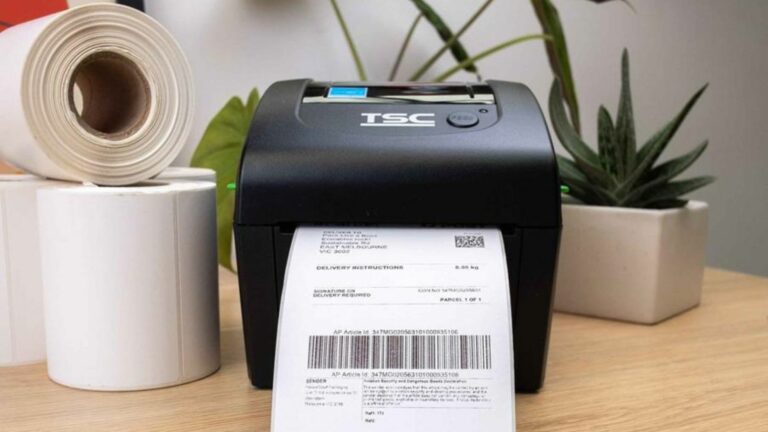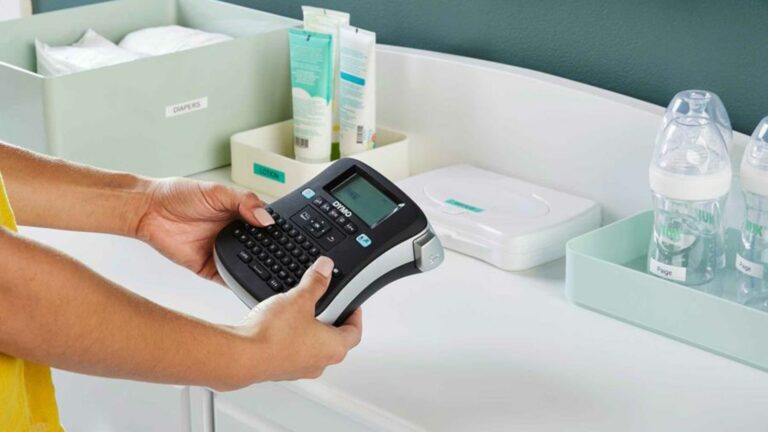Label makers have revolutionised the way you can organise and identify your belongings. These devices are indispensable tools for organisation in homes, offices, and various industries. Also known as labelling machines, label makers allow users to create custom labels quickly and easily. Whether you’re a small business owner, a teacher, or someone who loves an organised workspace, a label maker is an invaluable tool to have in your arsenal.
Types of Label Makers
Label makers come in a variety of styles and sizes, each tailored to specific needs. Here’s a breakdown of the main types of label makers on the market:
1. Handheld Label Makers
Handheld label makers are compact and easy to carry, making them ideal for schools, offices, and light-duty business use. They typically come with a keyboard and small screen, allowing users to input text and choose from a range of fonts and styles. Handheld label makers are commonly used for organising files, storage containers, and other small items around the office.
2. Desktop Label Makers
Desktop label makers are larger than handheld versions and are designed for more intensive labelling tasks. These models usually feature a full QWERTY keyboard, a large display, and advanced formatting options. They can be connected to a computer for easy editing and customisation, making them suitable for both office and small business environments.
3. Industrial Label Makers
Industrial label makers are built to withstand tough working conditions and are used in manufacturing, warehousing, and construction environments. These labelling machines produce highly durable labels that can withstand heat, moisture, chemicals, and abrasion. Some models can even print barcodes and QR codes, which are essential for inventory management and tracking.
4. Thermal Label Printers
Thermal label printers use heat to print images and text on specialised thermal paper, eliminating the need for ink or toner. They are highly efficient and widely used for printing shipping labels, barcode labels, and product labels. Thermal label printers come in both direct thermal and thermal transfer versions, with direct thermal being more popular for temporary labels and thermal transfer for long-lasting prints.
5. Inkjet and Laser Label Printers
For businesses that need high-quality, full-colour labels, inkjet and laser label printers are ideal. Unlike thermal label printers, these printers use ink or toner to print on label sheets. They offer higher print resolution, making them perfect for creating branded labels and colourful designs.

Components of a Label Maker
While the components may vary slightly across different types, most label makers consist of these essential parts:
- Print Head: The print head is the component that transfers the text or image onto the label material. In thermal label printers, the print head uses heat, while inkjet and laser labelling machines use ink or toner.
- Cartridge or Tape: Label makers use specialised cartridges or tape that contain label material. Common materials include vinyl, polyester, and paper, each suited for different purposes.
- Label Cartridge or Roll Holder: This component holds the label material and, in some cases, the ink ribbon.
- Label Feed Mechanism: This component moves the label material through the printer.
- Cutting Mechanism: Many label makers feature an automatic or manual cutter to separate printed labels. Industrial and desktop models may feature automatic cutters for continuous printing and precise cuts.
- Display Screen: Most label makers have a display screen to preview text, format options, and layout adjustments before printing. This is crucial for ensuring that labels appear exactly as intended.
- Keyboard: The keyboard is the main interface for inputting text. Handheld and desktop models typically have an alphanumeric or QWERTY keyboard.
- Connectivity Ports: Desktop and industrial label makers may include USB, Ethernet, or wireless connectivity options.
- Control Panel: Buttons or touchscreens for adjusting settings and initiating print jobs.
- Memory: Internal storage for saving label designs and templates.
- Power Source: Label makers are typically powered by batteries or an AC adapter. Handheld models are often battery-operated for portability, while desktop and industrial models may use AC power for longer usage.
How Labelling Machines Work
The process of using a label maker involves inputting text, selecting the desired format, and printing the label. Here’s a step-by-step breakdown of how most label makers operate:
- Inputting Text and Format: Users input the desired text using the keyboard and can customise it with options for font, size, alignment, and symbols.
- Previewing on Display: Most label makers allow users to preview their label on a screen. Adjustments can be made at this stage to ensure the text fits well within the label’s size.
- Printing Process: Once the label is ready, pressing the print button activates the print head. For thermal label printers, the print head heats up and transfers text or images onto the label material, which changes colour where the heat is applied.
- Cutting and Application: After printing, the cutter trims the label, making it ready for use. The label can then be applied to a variety of surfaces depending on the material used.
Common Uses of Label Makers
Labelling machines are versatile tools that serve multiple purposes across various settings. Here are some of the most common uses for these devices:
- Home Organisation: Label makers are popular among homeowners for organising everything from pantry shelves to storage bins. Clear labelling helps save time and keeps items organised, making daily routines smoother.
- Office Labelling: In the office, label makers help with filing systems, desk organisation, and cable management. Labelled folders, drawers, and cables can prevent confusion and boost productivity by reducing time spent searching for supplies.
- Retail and Inventory Management: Label makers, particularly thermal label printers, are essential in retail environments for printing price tags, barcodes, and product labels. They simplify inventory management, helping staff to locate products quickly and accurately track stock levels.
- Shipping and Logistics: Thermal label printers are widely used in logistics for printing shipping labels, barcode labels, and address labels. With high-speed printing and durable labels, these devices streamline the shipping process.
- Education and Schools: In educational settings, label makers are useful for labelling storage areas, equipment, and supplies, making classrooms and libraries more organised. Teachers also use them to create name tags, subject labels, and teaching aids.
Interesting Facts About Label Makers
Label makers have a rich history, and their design and technology have evolved significantly. Here are a few fun facts about label makers:
- Ancient Origins: The concept of labelling dates to ancient civilisations, with early forms of labels found on pottery and other artifacts.
- Dymo’s Innovation: The first handheld label maker was introduced by Dymo Industries in 1958, revolutionising personal organisation.
- Space-Age Technology: NASA uses specialised label makers to create labels that can withstand extreme temperatures and conditions in space.
- Environmental Impact: Many label maker manufacturers now offer eco-friendly label materials, including recyclable and biodegradable options.
- Braille Labelling: Some label makers can create Braille labels, improving accessibility for visually impaired individuals.
- QR Code Integration: Modern label makers can generate and print QR codes, linking physical objects to digital information.
- Label Maker Art: Some artists have embraced label makers as a medium, creating unique text-based artworks.
- Industry Growth: The global label maker market is expected to reach AUD 5.8 billion by 2030, driven by increasing demand for organisation and efficiency.
Choosing the Right Label Maker for Your Needs
Label makers have come a long way from their humble beginnings, evolving into sophisticated devices that cater to a wide range of organisational needs. From simple handheld units to advanced industrial labelling machines, these tools play a crucial role in improving efficiency and organisation across various sectors.
As technology continues to advance, we can expect label makers to become even more integrated into our daily lives, offering innovative solutions for both personal and professional organisation. Whether you’re tidying up your home office, managing a large warehouse, or anything in between, there’s a label maker designed to meet your specific needs.
With the right label maker at your disposal, you’ll be well-equipped to tackle any organisational challenge that comes your way.

